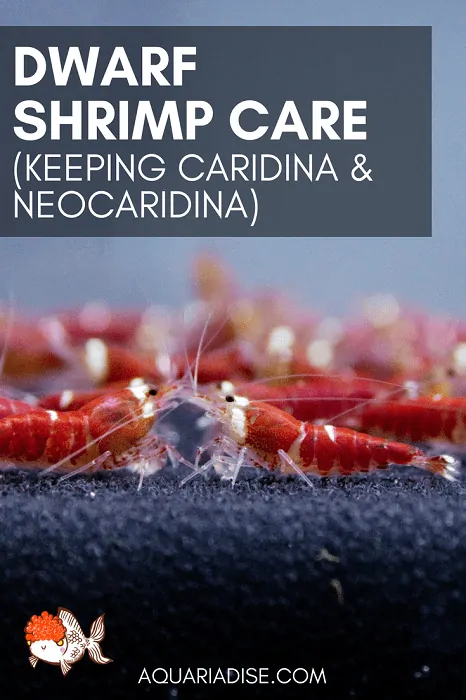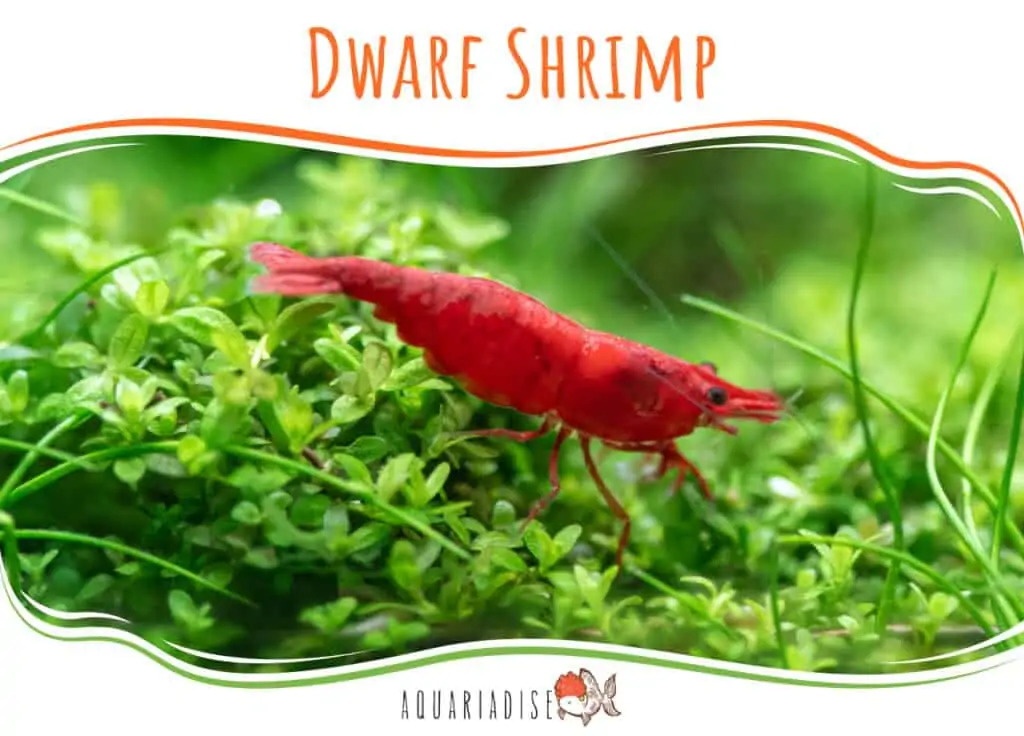Although an aquarium dedicated to something as seemingly boring as tiny shrimp may not be everyone’s cup of tea, the (dwarf) shrimp hobby is growing fast. Knowledge about their existence and care is spreading and exciting color varieties are being developed.
More and more aquarists are giving shrimp keeping a try; if you are, too, keep reading for more information about setting up an aquarium for Neocaridina and Caridina species like Cherry shrimp, Bee shrimp and Crystal reds.

Tank size & equipment
For a single species dwarf shrimp setup, a large aquarium is not necessary (although it’s always a possibility); most serious shrimp keepers prefer a size of around 10 gallons (38L). The other essentials are:
- Filter. Because shrimp may get stuck in powerful filters, it’s a good idea to use a filter that can be equipped with a filter guard.
- Heater. Although some shrimp do well in room temperature water, a heater protects them from sudden fluctuations.
- Thermometer. To spot heater malfunctions and other temperature issues right away, a thermometer is very important.
- Water testing kit. A test kit like this one is a must! As explained below, shrimp are very vulnerable to bad water quality.
- Water conditioner if chlorine is used in your tap water.
Water chemistry
Although there are many different Neocaridina and Caridina varieties and not all of them require the exact same water parameters, the most important thing you should keep in mind if you want to keep them is that they can be very fragile. Clean, conditioned water without any traces of ammonia or nitrite is a must and stability is crucial!
This means that a very small aquarium (under 5 gallons/18L) is not the best idea, as it will be too difficult to keep water values and temperature stable. It also means that your shrimp aquarium, like any other aquariums, should always be cycled before adding live animals and you should always have a liquid test kit to monitor water values.
A temperature between 70 °F/21 °C and 77 °C/25 °C should be suitable for almost all dwarf shrimp species, although some can withstand a much wider range. Higher temperatures lead to a faster life cycle, which means quicker growth and more breeding but also a much shorter life span. The preferred pH is not the same for all dwarf shrimp varieties, but something between 6-7 should be fine for most.
Setting up, decorations & tankmates
Setting up your aquarium in such a way that it makes an ideal habitat for dwarf shrimp is not too difficult. There are a few things to think about: hiding places/plants, tankmates and substrate. These are discussed below!
Hiding places & plants – If you’ve kept shrimp before, you’ve no doubt noticed that they really appreciate a few hiding spots and will often hang out in or around them. This is especially important when they’re molting, as they will be a bit more vulnerable and prefer a dark, safe spot.
Even if you’re keeping your shrimp tank relatively bare, a few hiding places are a must. Luckily, aquarium plants are very suitable for this! They have many benefits: shrimp will feel safer, which reduces stress, and also use plants to forage on. The plants will also help keep water values stable and give the aquarium a nice, natural look. Another great and widely used hiding option for shrimp are ceramic shrimp caves.
Tankmates – If you’re interested in keeping more than just shrimp, keep in mind that the average Neocaridina/Caridina setup is a bit too small for most tankmates. Almost all fish will also catch and eat shrimp fry or even adult dwarf shrimp, which isn’t really what you want when you’re trying to establish a large colony or keep one of the more expensive types.
If you want to keep your shrimp 100% safe, stick to a single species aquarium or maybe a few snails. Otocinclus species (pictured to the side) are also known for being very peaceful. Dwarf shrimp species that are relatively cheap and reproduce quickly enough, such as cherry shrimp, should do relatively well in densely planted peaceful community aquariums.
Note: Many dwarf shrimp species can and will interbreed. While they can live together peacefully, the offspring they produce will have a brownish wild color. To find out which dwarf shrimp can be safely combined, have a look at a compatibility chart!
Substrate – Your choice of substrate mostly depends on the type of dwarf shrimp you’re interested in keeping. For the more hardy species such as cherry shrimp, regular sand, fine gravel or even a bare bottom setup are all fine.
Some species, however, have more specific pH and water hardness requirements and your substrate can help you achieve their preferred range. Some of these active substrates will help keep the water slightly acidic (low pH). Others, such as crushed corals, will do the opposite and help keep the water more alkaline. This is great for shrimp that prefer a higher pH, such as Sulawesi shrimp.
More specific information about different dwarf shrimp species can be found here.
Dwarf shrimp diet
Not all dwarf shrimp species require the same diet and care, but there are definitely some guidelines that apply to all of them!
All dwarf shrimp are omnivores; they eat plant matter and meat and can be seen foraging on algae and micro organisms throughout the day. The gif below shows a foraging cherry shrimp. This means a varied diet is a great idea for your dwarf shrimp and you can feed them many different foods. There are commercial shrimp foods (such as this one) on the market that contain plant matter like algae along with proteins and extra calcium to promote healthy molting. However, although these are great as a staple there are tons of other things you can supplement with.
Fresh blanched vegetables are great shrimp food and will really be appreciated. In my experience, zucchini, leafy greens and peas are big favorites! Carrot is also sometimes recommended because it can enhance the color of your shrimp. You can also feed frozen foods, algae pellets and commercial fish foods in moderation.
Note: As discussed before shrimp are very sensitive to changes in water quality. This means any uneaten food should be removed within a few hours to prevent rotting and you should avoid overfeeding.
Dwarf shrimp maintenance
Because good water quality is so important for your dwarf shrimp, a 10-15% water change every week is recommended to keep most species healthy. The new water should be identical in temperature and dechlorinated if tap water in your country is disinfected with chloramine, which is lethal to all aquarium creatures. Some shrimp keepers choose to add Indian almond leaves to their shrimp setups, but this is completely optional. You can read more about Indian almond leaves here.
Because shrimp are so sensitive, there are a few other things to keep in mind. For example, copper, copper based and even some non-copper based fish medication can seriously harm them. Always research whether medication you want to use in your shrimp tank is actually safe or not before using it, as the wrong medication can kill off an entire colony. Wash any new plants/decorations before introducing them to the tank.
If you buy new shrimp, take some time to acclimate them properly, as a sudden change in water values can be fatal. Be very careful when using CO2 in a shrimp tank, as it causes pH swings that can be too much for them; using easy plants that don’t need CO2, such as Cryptocoryne is a simple solution for this issue.
Molting
Shrimp and other crustaceans have an exoskeleton that is unable to grow with them as they do. This means they have to molt regularly during their growing process. As mentioned before, it’s a good idea to feed calcium rich foods to help your shrimp build their new exoskeleton succesfully and prevent any problems with molting. If they are lacking in calcium, molts may get stuck, which can be fatal.
The molt is a very vulnerable period and the shrimp will usually find a safe place to do so. If you’re suddenly missing a shrimp, no worries! It may come out with a fresh shell after being gone for a while. If you find something in your tank that looks like a dead, empty shrimp as pictured above, you’ve stumbled upon a molt. It’s best to leave it in the tank as it provides useful nutrients and is often eaten.
Buying dwarf shrimp
If you’re looking to buy dwarf shrimp for your own aquarium, you may find that most local aquarium stores don’t carry that many varieties – usually just cherry shrimp. To find the shrimp you’re looking for, you may need to visit an aquarium show or a breeder.
Choose shrimp that are colorful, healthy looking and actively foraging!
As dwarf shrimp can be shipped, the easiest way to find a variety of shrimp types is to search online for a seller with good reviews. The Shrimp Farm sells many different types of dwarf shrimp on their website.
Conclusion
Keeping dwarf shrimp may seem like a bit of a challenge with all the “rules” regarding how sensitive and vulnerable they are. Don’t let this intimidate you! Start out with an easier species, like cherry shrimp. If you’d like, you can eventually move on to the more challenging types using the experience you’ve gained along the way.
Shrimp are not as difficult to care for as they sound and they’re definitely a lot of fun to keep and watch, which makes it all totally worth it.
If you still have questions about keeping dwarf shrimp or if you want to share your own experiences/tips, be sure to leave a comment below. Happy shrimp keeping!



1 thought on “Dwarf Shrimp Care | Keeping Neocaridina & Caridina”